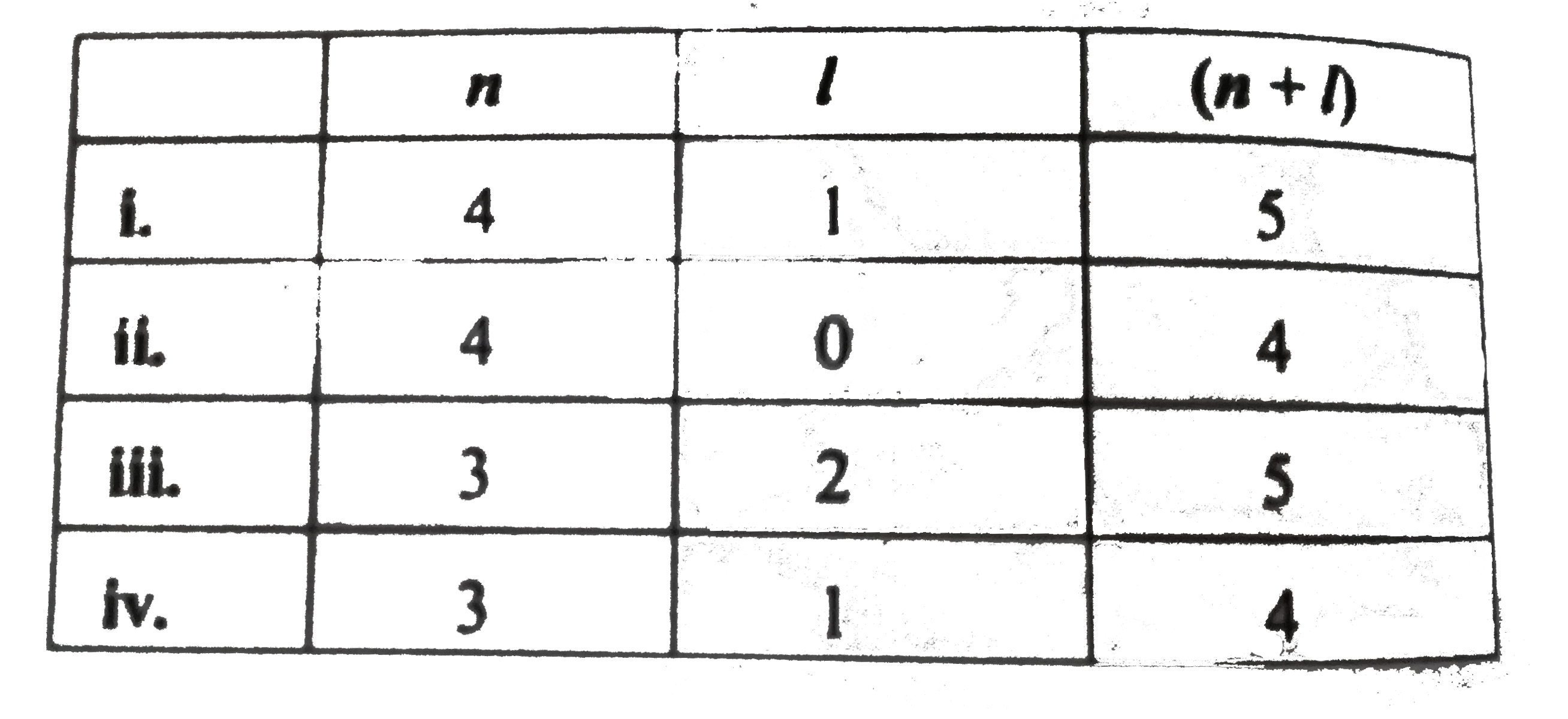The electrons, identified by quantum number n and l
i. n=4 ii. n=4,l=0 iii. n=3,l=2 iv. n=3,l=1
Can be palced in the order of increasing energy from the lowest to highest,its
iv lt ii lt iii lt i
ii lt iv lt i lt iii
i lt iii lt ii lt iv
iii lt i lt iv lt ii
The correct Answer is:A
(iv) lt (ii) lt (iii) lt (i)
According to Aflau's principal filing of electron in verious subshells of an atom taken place in the increasing value of energy staring with the lower most .The following order is observed
1s2s3s3p4s3d5s4d5p6s4f5d6p7s……According to Bohr- Bury rule (n+1) rule, the sub-shell with the lower value of (n+1) is filled first if the values for (n+1) are equal, the one with the smaller value of n filled first

Topper's Solved these Questions
- BOOK - CENGAGE CHEMISTRYCHAPTER - ATOMIC STRUCTUREEXERCISE - Archives Integer2videos
ATOMIC STRUCTURE
- BOOK - CENGAGE CHEMISTRYCHAPTER - ATOMIC STRUCTUREEXERCISE - Archives Fill In The Balnks8videos
ATOMIC STRUCTURE
- BOOK - CENGAGE CHEMISTRYCHAPTER - ATOMIC STRUCTUREEXERCISE - Archives Multiple Correct7videos
ATOMIC STRUCTURE
- BOOK - CENGAGE CHEMISTRYCHAPTER - APPENDIX - INORGANIC VOLUME 1EXERCISE - chapter-7 Single correct answer1videos
APPENDIX - INORGANIC VOLUME 1
- BOOK - CENGAGE CHEMISTRYCHAPTER - CHEMICAL BONDING AND MOLECULAR STRUCTUREEXERCISE - Archives Subjective15videos
CHEMICAL BONDING AND MOLECULAR STRUCTURE
Similar Questions
The electrons, identified by quantum numbers n and l(i) n=4,l=1 (ii) n=4, l=0 (iii) n=3,l=2 (iv) n=3, l=1 can be placed in order of increasing energy from the lowest to highest as
View SolutionThe electronic, identified by quantum numbers n and l, (i) n=4,l=1, (ii) n=4,l=0, (iii) n=3,l=2, (iv) n=3,l=1 can be placed in order of increasing energy, from the lowest to highest, as
View Solution
Knowledge Check
- Question 1 - Select One
The electrons identified by quantum numbers n and l
An=4 , l=1Bn=4 , l=0Cn=3 , l=2Dn=3 , l=1 - Question 2 - Select One
The electronic, identified by quantum numbers n and l, (i) n=4,l=1, (ii) n=4,l=0, (iii) n=3,l=2, (iv) n=3,l=1 can be placed in order of increasing energy, from the lowest to highest, as
A(iv)<(ii)<(iii)<(i)B(ii)<(iv)<(i)<(iii)C(i)<(iii)<(ii)<(iv)D(iii)<(i)<(iv)<(ii) - Question 3 - Select One
In an orbital electrons are filled according to Aufbau principle, Pauli's exclusion principle and Hund's rule of maximum muliplicity .
According to Aufbau principal the orbital are filled in order to their increasing energies . In the order of increase of energy of orbitals cna be calculated from (n+l) rule. Lower the value of (n+l) for an orbital the lowest energy hence orbital are filled in order of increasing (n+l) value. If two orbitals have same (n+l) value, the orbital with lower value of 'n' has lower energy hence it is filled first.
According to Pauli's exclusion principle, an orbital can have maximum two electrons with opposite spin.
According to Hunds rule pairing of electron in degenerate orbitals of the same sub shell does not take place until each orbital belonging to that sub shell has got one electron each i.e., singly occupied.
The electron identified by quantum number n & l
(i) n = 4, l = 1 (ii) n = 4, l = 0
( iii) n = 3, l = 2 (iv) n = 3, l = 1
can be placed in order of increasing energy from the lowest to the highest asA(iv)<(ii)<(iii)<(i)B(ii)<(iv)<(i)<(iii)C(i)<(iii)<(ii)<(iv)D(iii)<(i)<(iv)<(ii)
the electrons identified by quantum number n and l (i)n=4, l=1 (ii)n=4, l=0 (iii) n=3 , l= 2 and (iv) n=3, l=1 can be placed in order of increasing energy from the lowest to the highest as
View SolutionThe electronic, identified by quantum numbers n and l, (i) n=4,l=1, (ii) n=4,l=0, (iii) n=3,l=2, (iv) n=3,l=1 can be placed in order of increasing energy, from the lowest to highest, as
View SolutionThe electrons, identified by quantum number n and l:
(I) n=3,l=0 (II) n=5,l=2
(III) n=2,l =1 (IV) n=4,l=3
can be placed in order of increasing energy from the lowest to highest as:View SolutionThe electrons, identified by quantum number n and l:
(I) n=3,l=0 (II) n=5,l=2
(III) n=2,l =1 (IV) n=4,l=3
can be placed in order of increasing energy from the lowest to highest as:View SolutionThe electrons, identified by quantum number n and l:
(I) n=3,l=0 (II) n=5,l=2
(III) n=2,l =1 (IV) n=4,l=3
can be placed in order of increasing energy from the lowest to highest as:View Solution

